Common Core of Data - Teacher Compensation Survey (TCS) 2010-13
Common Core of Data - Teacher Compensation Survey (TCS) 2010-13
TCS 2010-2013 Appendix A-Instruction Manual
Common Core of Data - Teacher Compensation Survey (TCS) 2010-13
OMB: 1850-0874

Teacher Compensation Survey
School Year 2009 – 2010
Instruction Manual
Last revised: June 24, 2010
OMB Control No.: 1850-NEW
OMB Expiration Date: September 30, 2013
Burden Statement:
According to the Paperwork Reduction Act of 1995, no persons are required to respond to a collection of information unless such collection displays a valid OMB control number. The valid OMB control number for this information collection is 1850-NEW. The time required to complete this information collection is estimated to average 86 hours, including the time to review instructions, search existing data resources, gather the data needed, and complete and review the information collection. If you have any comments concerning the accuracy of the time estimate(s) or suggestions for improving this survey, please write to: U.S. Department of Education, Washington, D.C. 20202-4537. If you have any comments or concerns regarding the status of your individual submission of this form, write directly to: National Center for Education Statistics, 1990 K Street, NW, Washington, DC 20006.
U.S. Department of Education
Arne Duncan
Secretary
Institute of Education Sciences
John Q. Easton
Director
National Center for Education Statistics
Stuart Kerachsky
Acting Commissioner
Elementary/Secondary and Libraries Studies Division
Jeffrey Owings
Associate Commissioner
Elementary/Secondary Cooperative System and Institutional Studies Program
Lee McGraw Hoffman
Program Director
The National Center for Education Statistics (NCES) is the primary federal entity for collecting, analyzing, and reporting data related to education in the United States and other nations. It fulfills a congressional mandate to collect, collate, analyze, and report full and complete statistics on the condition of education in the United States; conduct and publish reports and specialized analyses of the meaning and significance of such statistics; assist state and local education agencies in improving their statistical systems; and review and report on education activities in foreign countries.
NCES activities are designed to address high-priority education data needs; provide consistent, reliable, complete, and accurate indicators of education status and trends; and report timely, useful, and high-quality data to the U.S. Department of Education, the Congress, the states, other education policymakers, practitioners, data users, and the general public. Unless specifically noted, all information contained herein is in the public domain.
We strive to make our products available in a variety of formats and in language that is appropriate to a variety of audiences. You, as our customer, are the best judge of our success in communicating information effectively. If you have any comments or suggestions about this or any other NCES product or report, we would like to hear from you. Please direct your comments to
National Center for Education Statistics
Institute of Education Sciences
U.S. Department of Education
1990 K Street NW
Washington, DC 20006-5651
April 2010
Content Contact
Stephen Cornman
(202) 502-7338
Table of Contents
General Information on the Website 5
Instructions for Creating a Data File 5
Instructions for Uploading Data 6
Instructions for Downloading Reports 12
Instructions for Submitting the TCS Data Plan 15
Appendix A. Data Item Definitions 19
Teacher Compensation Survey
School Year 2009-2010
Introduction
The National Center for Education Statistics (NCES) of the Institute of Education Sciences (IES), U.S. Department of Education, is conducting the Teacher Compensation Survey (TCS) to collect compensation data for all public school teachers, as authorized under Section 153(a) of the Education Sciences Reform Act of 2002 (ESRA; H.R. 3801). The U.S. Census Bureau collects TCS data for NCES. The collected information includes base and total salaries, expenditures for benefits, highest degree earned, years of teaching experience, age, race, and gender data. This information can be used by researchers and administrators to determine teacher retention and turnover, and also identify patterns of teacher mobility.
The information you provide as part of this voluntary survey is protected by federal statute (ESRA; P.L. 107-279, Title I, Part E, Sec. 183). Your answers may be used only for statistical purposes and may not be disclosed, or used, in identifiable form for any other purpose except as required by law. The Teacher Compensation Survey will become part of the Common Core of Data series. The teacher-level data will only be available to researchers with an IES Restricted-Use Data License. Summaries of the data at the school and district levels will be published on the web after suppression of salary and benefits data in small cells (i.e., cases where averages or totals are based on fewer than 3 teachers).
Survey respondents can refer to the Teacher Compensation Website, https://harvester.census.gov/tcs.
Survey Deadline
The deadline for uploading TCS information is September 3, 2011.
Contact Information
Stephen Cornman
Project Director
(202) 502-7338
Liz Holland
Project Manager
(301) 763-7351
TCS Staff
Phone: (800) 437-4196
Fax: (877) 574-6549
E-mail: [email protected]
Website: https://harvester.census.gov/tcs
Background
Why are we collecting teacher-level salary and benefits data?
Teachers are the largest component of school spending, with more funding being allocated to teacher salaries than to any other education expense. Expenditures for salaries and benefits of teachers alone make up more than half (54 percent per NPEFS FY 2006) of the current expenditures made by school districts. Yet, there is not a wealth of data on teacher compensation. National data on teachers are limited to periodic sample surveys or to simple counts at the district or school level. School districts and states often maintain significant databases on teachers in their jurisdictions, but these databases are rarely comparable across states. Some databases contain personally identifiable or sensitive information (e.g., Social Security Number), thereby preventing them from being available to researchers and the public. In response to the need for individual teacher-level data to address education policy issues, the National Center for Education Statistics (NCES) developed the Teacher Compensation Survey (TCS), an administrative records universe survey that collects total compensation, teacher status, and demographic data about all public school teachers from multiple states.
General Information on the Website
A website for submitting data securely has been developed by the U.S. Census Bureau and NCES. Please use this secure site to submit your data. The site contains no interactive, on-line editing features. It contains instructions for submitting data, TCS data item definitions, record layout, data plan, and other information necessary to submit the data file. The Census Bureau is the teacher compensation data collector for NCES. For questions regarding this survey, please visit the Frequently Asked Questions (FAQ) section or contact the Teacher Compensation Survey staff.
Instructions for Creating a Data File
Before creating the data file, review the record layout and data item definitions. Please pay particular attention to the values for the indicator variables.
Create either a comma-delimited (.csv) or MS Access (.mdb) file. Ensure that data items are in the same order and reflect the same type as specified in the record layout (Appendix B).
The data file should contain a record for each teacher at every school where they teach.
Examples:
A teacher that teaches at one school should have one record.
A teacher that teaches at two or more schools:
Should have a corresponding number of records and the full-time equivalency (FTE) for each record should reflect the time the teacher spends at each school. The FTE should be rounded to two decimal places.
The other data (i.e., Total Salary, Base Salary, Total Benefits, etc.) should be prorated using the FTE.
A teacher that teaches at one school but teaches multiple classes should have one record.
If an itinerant teacher, a teacher that teaches in several schools, is not assigned to specific schools then report one record for that teacher with NCES school ID (SCHNO) reported as ‘99999’ and the school name (SCHNAM) and state school ID (SEASCH) reported as N (non-applicable).
Technical Assistance
If your agency experiences any difficulty in uploading the data please be advised that NCES and Census Bureau personnel are available to provide technical assistance. Please contact Census Bureau staff at (800) 437-4196 or [email protected] or contact Stephen Cornman via e-mail at [email protected] or by phone at (202) 502-7338.
Instructions for Uploading Data
When you go to the Teacher Compensation Survey Website, https://harvester.census.gov/tcs, you will see a menu across the top of the homepage. Download the TCS instruction manual by selecting the Instruction Manual link. NCES and representatives of state education agencies (SEAs) have developed common data items and definitions in order to collect and report comparable data across states. Comparable definitions facilitate state-by-state comparisons in NCES publications. The data items and definitions can be found on page 16. Please review the data item definitions before creating your state’s data file.
The data that you provide should be in record layout order. Submit only comma-delimited (.csv) or MS Access (.mdb) files. If you cannot submit data in these formats, please contact us at (800) 437-4196.
When you are ready to upload your data, go to the TCS website and log in by typing your User ID and TCS password. Please note that your password is case-sensitive. If you type your password incorrectly three times, the website will lock you out for fifteen minutes. After fifteen minutes, you will be able to attempt to log in to the website again.
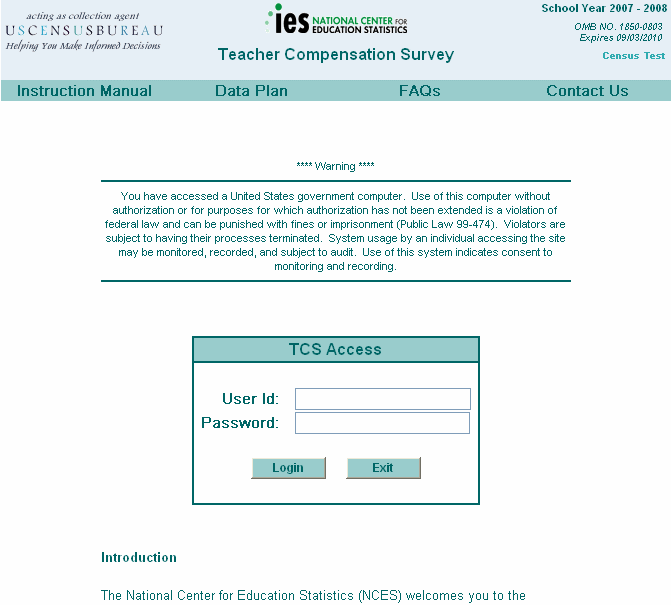
After successfully logging in, you will see the Survey Status Information screen. This page provides information about your file submission(s), edit report(s), and data plan progress. When you begin the survey, the number of file submissions and edit listings will be “0” and the status of your data plan will be “not yet started.” This information will change as you progress through the application.
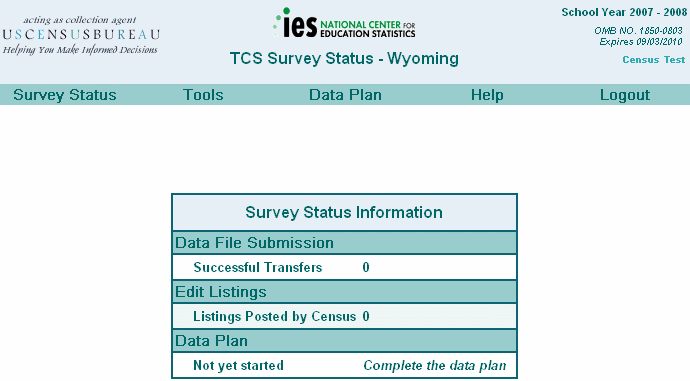
To upload your TCS data files, select Tools and then select Transfer Data Files.
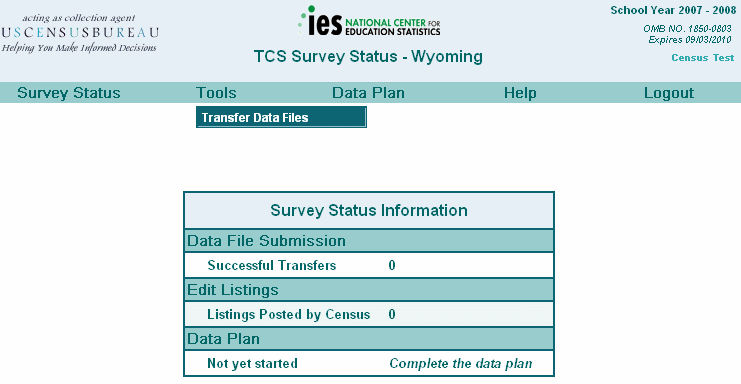
Next, you will see the Respondent Data File Transfer screen. To upload your TCS data file, select the Browse button and navigate to the location of the desired file.
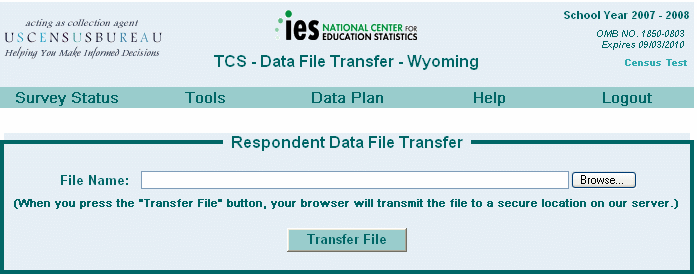
After the data file is located, select the file, and then select Open.
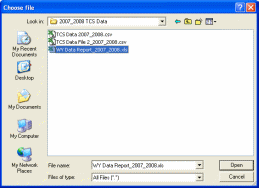
Next, select Transfer File. The file will be transmitted to a secure location on our server. If the file transfer was successful, you will receive a confirmation message. The total number of data files transferred to date will be visible in the section Files Successfully Transferred. The most recently transferred file will be highlighted in yellow.
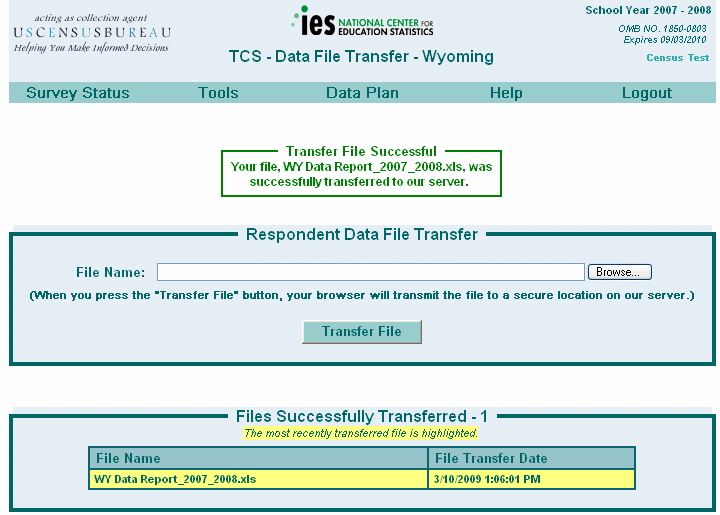
When you return to the Survey Status Information screen, the number of successfully transferred files will be reflected under Data File Submission, Successful Transfers. You will also see the date and time of the last successful transfer next to Last Transfer Date.
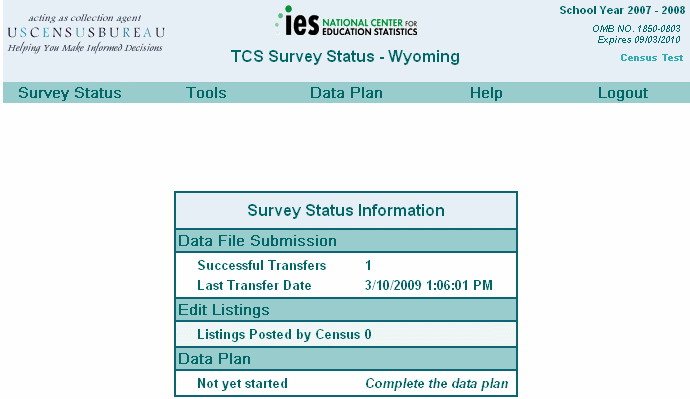

The TCS website now displays all files that have been successfully uploaded to our server. For example, if you have successfully transferred two files, the Respondent Data File Transfer screen will look like this:
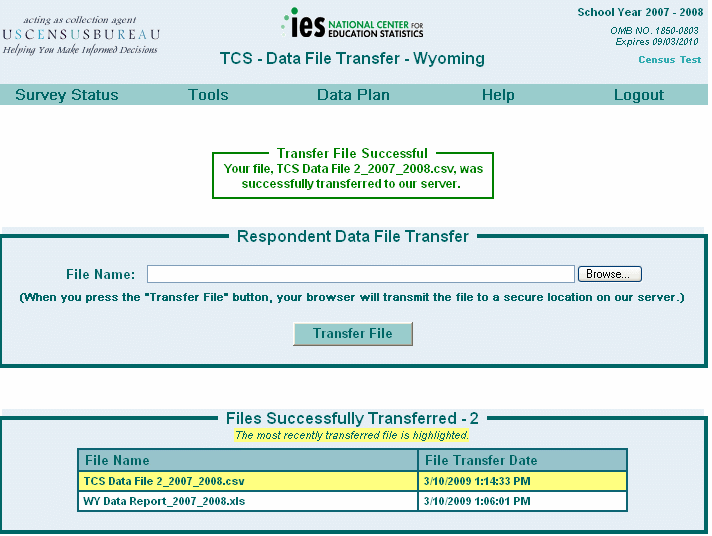
The Survey Status Information screen will also reflect that there have been two successful transfers under Data File Submission:


Instructions for Downloading Reports
After submitting data, an analyst will review the information and run the data file through an editing process that checks for completeness, outliers, and overall data quality. Individual record edit failures will be compiled into an Edit Listing and uploaded onto the TCS website for each state to download and review. These will usually be Excel spreadsheets. Frequencies, comments about the file, formatting issues, and ID match issues may also be uploaded to the site (usually a Word document). When an analyst uploads information to the TCS website for review, the state respondent will receive notification via email.
To download an Edit Listing, go to the TCS website (https://harvester.census.gov/tcs) and log on by typing your User ID and TCS password. Please note that your password is case-sensitive. If you type your password incorrectly three times, you will be locked out for fifteen minutes. After fifteen minutes, you will be able to log on to the website again.
After successfully logging in, you will see the Survey Status Information screen. This page provides information about your file submission(s), edit report(s), and data plan progress.
To download your State Summary and Edit Listing, select Download Edit Reports. The menu option Download Edit Reports only appears if there is a file to download.

Select the Download File button that corresponds to the file that you want to download.
A dialog box will appear asking if you would like to open or save the file. Select Save.
Select a location on your computer where you want to download the file.
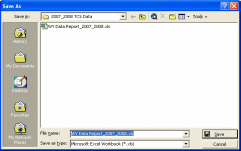
Select Save. If the file download was successful, you will receive confirmation that your download is complete.
In this example, two files have been posted by the Census Bureau and no files have been downloaded by the respondent.

In this example, the Data File Submission shows that a respondent has successfully transferred two files. The Edit Listings show that two files have been posted by the Census Bureau and one Edit Listing has been downloaded by the respondent.
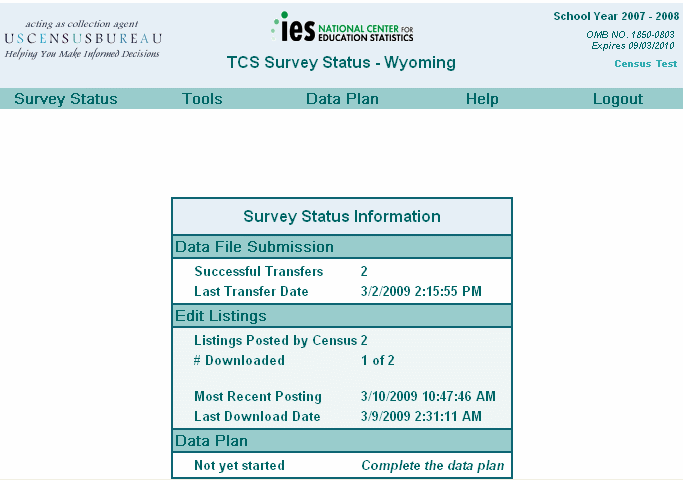

To exit the TCS website, select Logout. You will see the message below confirming that you are logged out of the Teacher Compensation Survey.
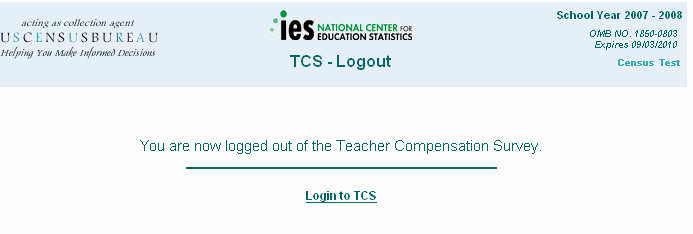
Instructions for Submitting the TCS Data Plan
The TCS data plan requests background information about the data and helps the Census Bureau, NCES, and researchers to properly analyze each state’s submission. This year, the data plan will be completed within the TCS website. Respondents will be able to save their answers online and return to complete the data plan at a later time. Respondents will still be able to print a copy of the data plan for their records. The instructions below will tell you how to download the data plan, print a copy, and submit the data plan to the Census Bureau.
To begin the data plan:
From the Survey Status Information screen, select Data Plan and then select Key Data Plan. Respondents can enter responses to specific questions on this page.
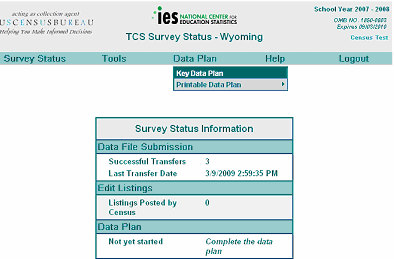
While working, respondents can save responses to the data plan and return to complete the form at a later date. The Survey Status Submission screen tracks respondent’s progress of the Data Plan.


To submit your completed data plan, select Lock Data Plan. A pop-up box will appear asking to confirm that your data plan is ready for final submission. Select Yes, Lock Data Plan. If you do not want to submit your data plan, select No, Cancel Locking.
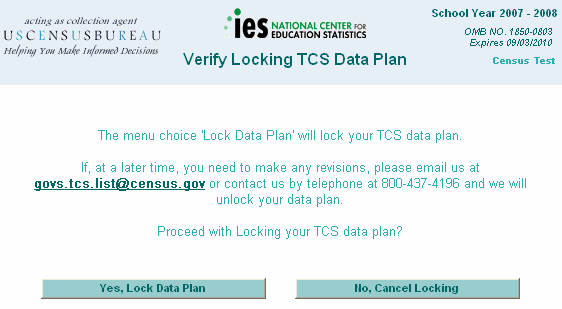
After submitting the data plan, respondents will not be allowed to edit their answers. However, respondents will be allowed to view and print their answers. The Survey Status Information screen will display the message “Plan Locked.”
To print a copy for your records select Data Plan, Printable Data Plan and then select With Data. To print a blank copy of the data plan, select Data Plan, Printable Data Plan and then select Blank.


Help Menu Items
The Help menu provides valuable resources for completing the Teacher Compensation Survey. Respondents can download the instruction manual, which provides data item definitions, instructions for completing the survey, Frequently Asked Questions, and the record layout. If respondents need quick access to the record layout or Frequently Asked Questions, the information can be downloaded easily from the Help menu. Respondents can also find contact information for the TCS staff by selecting Contact Us.

Appendix A. Data Item Definitions
All Other Benefits: All other benefits (excluding retirement and health insurance) paid by the school district and other government agencies for the teacher. Report all other benefits rounded to the nearest dollar.
Base Salary: The negotiated annual base salary for teaching duties for school year 2009-2010. Exclude bonuses, extra pay for extra duties, etc. Base salary should only include pay for teaching duties at the specific school indicated on the file. Report base salary rounded to the nearest dollar.
Contract Days: Number of days specified in teacher contract.
District New Teacher Indicator: This item indicates whether or not a teacher is new in the district.
1 = Yes. The teacher is new to the district.
2 = No. The teacher is not new to the district.
M = Missing
Full-time Equivalency (FTE): State (or district’s) FTE value for this teacher. The amount of time required to perform teaching assignments stated as a proportion of a full-time position. FTE is calculated by dividing the amount of time employed by the time normally required for a full-time position. (This item will also be used to help NCES identify part-time teachers and to determine how much of the reported salary should be considered as going to teaching duties.)
If a teacher teaches at more than one school, report a separate record for that teacher, for each school. The FTE number should reflect the FTE for that teacher in that specific school. Please prorate the salary and benefits received by the teacher across each school. The FTE should be rounded to two decimal places.
Gender: Please indicate whether the teacher is female or male. If the gender is unknown, report the value as missing.
1 = Male
2 = Female
M = Missing
Health Benefits: All amounts paid by school district and other government agencies for this teacher’s health insurance. Report health benefits rounded to the nearest dollar.
Highest Degree Earned: A degree is an award conferred by a college, university, or other postsecondary education institution as official recognition for the successful completion of a program of studies. Please do not consider additional coursework in this indicator.
1 = Less than a bachelor’s degree
2 = Bachelor’s degree
3 = Master’s degree
4 = Doctorate degree
M = Missing
Bachelor’s degree: An award (baccalaureate or equivalent degree, as determined by the Secretary, U.S. Department of Education) that normally requires at least four but not more than five years of full-time equivalent college-level work. This includes all bachelor's degrees conferred in a five-year cooperative (work-study) program. A cooperative plan provides for alternate class attendance and employment in business, industry, or government; thus, it allows students to combine actual work experience with their college studies. Also includes bachelor's degrees in which the normal four years of work are completed in three years.
Master’s degree: An award that normally requires the successful completion of a program of study of at least the full-time equivalent of one or two academic years of work beyond the bachelor's degree.
Doctorate degree: The highest award a student can earn for graduate study. The doctor's degree classification includes such degrees as Doctor of Education, Doctor of Juridical Science, Doctor of Public Health, and the Doctor of Philosophy degree in any field such as agronomy, food technology, education, engineering, public administration, ophthalmology, or radiology.
NCES Agency and School ID: The NCES agency identification number (LEAID) has seven characters: a two-digit state code followed by a five-digit number - that is unique to each agency within the state. Schools are assigned a five-digit NCES school identification number (SCHNO). The LEAID and SCHNO are the numbers that have been assigned by NCES through the CCD or EDEN collection system.
If a teacher teaches at more than one school, report a separate record for that teacher, for each school. The FTE number should reflect the FTE for that teacher in that specific school. Please prorate the salary and benefits received by the teacher, prorated across each school. For example, a teacher with 0.3 FTE in one school, 0.3 FTE in another school and 0.4 FTE in another school should have 30 percent of her salary reported with the first school, and 30 percent of her salary with the 2nd school, and 40 percent of her salary with the 3rd school. Race, gender, years of experience and other descriptive statistics should be duplicated on each record. Itinerant teachers that teach in several schools may be linked to just a school district.
Race/Ethnicity: Categories used to describe groups to which individuals belong, identify with, or belong in the eyes of the community. The categories do not denote scientific definitions of anthropological origins. A person may be counted in only one group. When reporting the data for the 2009-2010 school year the SEAs may elect to report some racial and ethnic data with the 5 traditional categories and others with 7 new categories.
1 = American Indian/Alaskan Native
2 = Asian/Pacific Islander
3 = Hispanic
4 = Black, not of Hispanic origin
5 = White, not of Hispanic origin
6 = None of the above
M = Missing
American Indian/Alaska Native: A person having origins in any of the original peoples of North and South America (including Central America), and who maintains tribal affiliation or community attachment.
Asian/Pacific Islander: A person having origins in any of the original peoples of the Far East, Southeast Asia, or the Indian subcontinent, including, for example, Cambodia, China, India, Japan, Korea, Malaysia, Pakistan, the Philippine Islands, Thailand, and Vietnam.
Hispanic or Latino: A person of Cuban, Mexican, Puerto Rican, South or Central American, or other Spanish culture or origin, regardless of race.
Black or African American: A person having origins in any of the black racial groups of Africa.
White: A person having origins in any of the original peoples of Europe, the Middle East, or North Africa.
For the 2010-11, 2011-12, and 2012-13 school years the following race and ethnicity categories should be utilized for reporting data:
1 = American Indian or Alaskan Native
2 = Asian
3 =Black or African American
4 = Hispanic/Latino
5 = Native Hawaiian or Other Pacific Islander
6 = White, not of Hispanic origin
7 = Two or more races
American Indian/Alaska Native: A person having origins in any of the original peoples of North and South America (including Central America), and who maintains tribal affiliation or community attachment.
Asian: A person having origins in any of the original people of the Far East, Southeast Asia or the Indian subcontinent , including, for example, Cambodia, China, India, Japan, Korea, Malaysia, Pakistan, the Philippine Islands, Thailand, and Vietnam.
Black or African American: A person having origins in any of the black racial groups of Africa.
Hispanic or Latino: A person of Cuban, Mexican, Puerto Rican, South or Central American, or other Spanish culture or origin, regardless of race. Used interchangeably with the shortened term Hispanic.
Native Hawaiian or Other Pacific Islander: A person having origins in any of the original peoples of Hawaii, Guam, Samoa, or other Pacific Islands.
White: A person having origins in any of the original peoples of Europe, the Middle East, or North Africa.
Two or more races: A person identifying himself or herself as of two or more of the following race groups: White, Black, Hispanic, Asian, Native Hawaiian, or Other Pacific Islander, or American Indian or Alaska Native.
Retirement Benefits: All amounts paid by the school district, municipal, state, and other governments towards this teacher’s retirement plan. Report retirement benefits rounded to the nearest dollar.
School Name: Names of schools are the common designations or titles as they are known by the reporting agency. Report names for all schools. Abbreviate school names longer than 50 characters. Report the entire name of individual schools including the type of grade served. For example, “Jones School” should be specified as Jones Elementary School, Jones Middle School, or Jones High School. If the teacher teaches at more than one school, report a separate record for that teacher, for each school. Please report the salary of the teacher applicable to each school.
School Year: The year for which you are reporting data. In most cases the school year runs from July 1 to June 30. We are asking for data for the 2009-2010 school year. The school year should be reported as eight characters. For example, the 2009-2010 school year would be reported as “20092010.”
State Abbreviation: Two-letter U.S. Postal Service abbreviation for the state where the mailing address is located (e.g., AK for Alaska).
State Local Education Agency and School ID: State local education agency identification numbers (STID) are assigned by the state education agency. Once assigned, these numbers are maintained and used by NCES to verify record identity. A state’s education agency number may be any combination of letters and numbers up to 14 characters.
A state’s school identification number (SEASCH) may be any combination of letters and numbers up to 20 characters. For each school, report the assigned school and agency identification numbers. If schools are not assigned state identification numbers, enter code N. Provide documentation for any missing or inconsistent state identification numbers.
State New Teacher Indicator: This item indicates whether or not a teacher is new in the state.
1 = Yes. The teacher is new to the state.
2 = No. The teacher is not new to the state.
M = Missing
For each teacher reported on the file, if the State New Teacher Indicator is 1, the District New Teacher Indicator must be 1. If the District New Teacher Indicator is 2, the State New Teacher Indicator must be 2.
State Teacher ID: A unique teacher identification number provided by the state. This number does not change over time and it identifies each teacher within the state. Please do not send social security numbers. NCES and the Census Bureau can provide some technical assistance in developing unique teacher identifiers. Please contact the Census Bureau staff at (800) 437-4196 or [email protected], or contact Stephen Cornman via e-mail at [email protected] or by phone at (202) 502-7338.
Substitute Teacher: Individuals who fill the role of a regular teacher.
Teacher: We are asking for data on all teachers in your state, both certified and non-certified. Please include only those staff persons that are employees of a school district or state education agency. Exclude staff that do not keep attendance records or assign grades to students.
Teacher Salary Indicator: This item indicates whether or not a teacher’s “Base Salary” includes pay for other official assignments (such as administration, curriculum coordinator, guidance counseling, etc.).
1 = Yes. The base salary includes pay for other official duties besides teaching.
2 = No. The base salary includes pay for teaching duties only.
M = Missing
Teacher Status Indicator: This indicator is used to determine the teacher’s employment status.
1 = Full-time teacher at one school only
2 = Full-time teacher assigned to several schools
3 = Part-time teacher, full-time employee, at one school only; (teacher is a full-time employee, but has other recognized duties such a principal, administrator, guidance counselor, etc.)
4 = Part-time teacher, full-time employee, assigned to several schools (teacher is a full-time employee, but has other recognized duties such a principal, administrator, guidance counselor, etc.)
5 = Part-time employee whose only primary duty is a teacher
6 = Part-time employee who teaches and performs other duties
= Substitute teacher
M = Missing
Total Benefits: Sum of retirement, health, and all other benefits, or total benefits paid by the district and/or state if unable to breakout retirement and health benefits. Report total benefits rounded to the nearest dollar.
Total Pay: The total amount of money paid to this teacher (for school year 2009-2010). (The amount reported for Total Pay is supposed to be greater than or equal to Base Salary.) Report total pay rounded to the nearest dollar.
Year of Birth: Teacher’s year of birth.
Years of Experience: Years of teaching experience recognized by the school district or state education agency as of the end of the school year. New full-time teachers, hired at the beginning of the school year (with no previous experience), should be reported as having 1 year of experience.
Appendix B. Record Layout
Data Field |
Description |
Length |
Type |
Position |
Values |
STABBR |
State Abbreviation |
2 |
Alpha |
1-2 |
|
STTEACHID |
State Teacher ID |
30 |
Alpha |
3-32 |
|
LEAID |
NCES Agency ID |
7 |
Alpha |
33-39 |
|
SCHNO |
NCES School ID |
5 |
Alpha |
40-44 |
|
STID |
State Agency ID |
14 |
Alpha |
45-58 |
|
SEASCH |
State School ID |
20 |
Alpha |
59-78 |
|
SCHNAM |
School Name |
60 |
Alpha |
79-138 |
|
YEAR |
School Year |
8 |
Alpha |
139-146 |
|
BASESAL |
Base Salary |
9 |
Numeric |
147-155 |
> 0 -1 = missing |
TOTPAY |
Total Pay |
9 |
Numeric |
156-164 |
> 0 -1 = missing |
RETIREBEN |
Retirement Benefits |
9 |
Numeric |
165-173 |
> 0 -1 = missing |
HEALTHBEN |
Health Benefits |
9 |
Numeric |
174-182 |
> 0 -1 = missing |
OTHERBEN |
All Other Benefits |
9 |
Numeric |
183-191 |
> 0 -1 = missing |
TOTALBEN |
Total Benefits |
9 |
Numeric |
192-200 |
> 0 -1 = missing |
EXP |
Years of Experience |
2 |
Numeric |
201-202 |
> 0 -1 = missing |
DEGREE |
Highest Degree Earned |
1 |
Alpha |
203 |
1 = Less than a bachelor's degree 2 = Bachelor's degree 3 = Master's degree 4 = Doctorate degree M = Missing |
RACE |
Race/Ethnicity |
1 |
Alpha |
204 |
1 = American Indian/ Alaska Native 2 = Asian/Pacific Islander 3 = Hispanic 4 = Black, Not Hispanic 5 = White, Not Hispanic 6 = None of the above M = Missing |
GENDER |
Gender |
1 |
Alpha |
205 |
1 = Male 2 = Female M = Missing |
BRTHYR |
Birth Year |
4 |
Alpha |
206-209 |
> 0 M = missing |
Data Field |
Description |
Length |
Type |
Position |
Values |
CONTRCTDAYS |
Contract Days |
5 |
Numeric |
210-214 |
> 0 -1 = missing |
FTE |
FTE |
4 |
Numeric |
215-218 |
> 0 -1 = missing |
TCHSTSIND |
Teacher Status Indicator |
1 |
Alpha |
219 |
1 = Full-time teacher at one school only 2 = Full-time teacher assigned to several schools (itinerant teacher) 3 = Full-time employee, part-time teacher, at one school only; (teacher is a full-time employee, but has other recognized duties such as a principal, administrator, guidance counselor, etc.) 4 = Full-time employee, part-time teacher, assigned to several schools (teacher is a full-time employee, but has other recognized duties such as a principal, administrator, guidance counselor, etc.) 5 = Part-time employee whose only primary duty is a teacher 6 = Part-time employee who teaches and performs other duties 7 = Substitute teacher M = Missing |
SALIND |
Teacher Salary Indicator |
1 |
Alpha |
220 |
1 = Yes. The base salary includes pay for other official duties besides teaching. 2 = No. The base salary includes pay for teaching duties only. M = Missing |
DSTNEWTCHIND |
District New Teacher Indicator |
1 |
Alpha |
221 |
1 = Yes. The teacher is new to the district. 2 = No. The teacher is not new to the district. M = Missing |
STNEWTCHIND |
State New Teacher Indicator |
1 |
Alpha |
222 |
1 = Yes. The teacher is new to the state. 2 = No. The teacher is not new to the state. M = Missing |
Appendix C. Frequently Asked Questions
Website Access
I forgot my password. Who do I call?
Contact the Teacher Compensation Survey staff at (800) 437-4196 or [email protected].
I have tried to log on to the TCS website repeatedly and I cannot. What is wrong?
Your password is case-sensitive. If you type your password incorrectly three times, the website will lock you out for fifteen minutes. After fifteen minutes, you will be able to log on to the website again. If you cannot remember your password, contact the Teacher Compensation Survey staff at (800) 437-4196.
Data Plan
I completed and locked my data plan, but I need to make changes. How can I unlock my data plan?
An analyst from the Teacher Compensation Survey can unlock your data plan. Please contact the Teacher Compensation Survey staff at (800) 437-4196 or [email protected].
Teacher IDs
My state uses Social Security numbers for teacher IDs. What should be used to uniquely identify each teacher?
Please note that we do not accept Social Security numbers. To uniquely identify each teacher, please number each teacher sequentially. For example, the first teacher in your data file will have the teacher ID 1 and the second teacher will have the teacher ID 2. These numbers should not change between years. Keep a file with the crosswalk of social security numbers to the unique sequential numbers for cross-referencing. Make sure that if you have multiple records for the same teacher, each record for that teacher has the same ID.
File Type
I do not have the data in an MS Access or comma-delimited file.
Please call the Teacher Compensation Survey staff at (800) 437-4196. Our staff will assist you.
Reporting Data Items
I cannot include expenditures for summer school teachers in the Total Salary item.
Report as much of the total salary that the teacher receives from the school district as possible and document the absence of summer school pay in the data plan.
Teacher Compensation Survey
Frequently Asked Questions
I cannot report any employee benefits or some of the other data items.
Please report all of the data that you have for teachers.
Edit Reports
I have been informed that there are many errors and inconsistencies on my data file. Can I submit a new file?
Yes, we encourage new file submissions for revised data. We will rerun the same edits and contact you if there are further problems.
I have been informed that there are a few minor errors and inconsistencies on my file. Can I submit corrections for specific records?
Yes. If there are a limited number of corrections (e.g., less than 50 records), we are more than willing to assist you by making the corrections to the file.
I downloaded an Edit Report. How long do I have to look over the information? What is the timeframe to respond?
Our preference is two weeks, but please call the Teacher Compensation Survey staff at (800) 437-4196 if you have special circumstances. We understand workload challenges and we value your time.
Common Reporting Errors
What are the most common reporting errors? What are some of the things you look for when going through the data?
Some common reporting errors include:
mathematical errors (e.g., The sum of detail does not equal the total.)
outliers (e.g., Teacher salary or benefits data exceeding $150,000.)
blank fields, improper values for missing data
inaccurate teacher FTE
contract days reported with a value greater than 365 days
unique teacher IDs with inconsistent characteristics across multiple records. For example, a teacher with two records may have ten years of experience on one record and three years of experience on another record.
Teacher Compensation Survey
Frequently Asked Questions
Are there any special edits that I can run to check the file before I send it?
Here are a few easy edits to check before sending your data file:
duplicate records
blank fields
correct school year (20092010)
outliers (i.e., extremely high or extremely low salaries, benefits, birth years, years of experience, etc.)
data type (i.e., character or numeric) matches the record layout
ratio of benefits to salary
consistency between the data file and the data plan (e.g., If the data plan says FTE cannot be greater than 1, the data file does not contain records with FTE greater than 1.)
Interpreting Scenarios
Example 1
“Ginny” works at School A as a principal 75% of the time and teaches at School B 25% of the time.
Question: Which Teacher Status Indicator would be used?
#3 – Part-time teacher, full-time employee, at one school only.
#4 – Part-time teacher, full-time employee, part-time teacher, assigned to several schools.
Answer: Status Indicator #3 – “Part-time teacher, full-time employee, at one school only.”
Example 2
A person is under contract with one district as a full-time employee hired for duties for which licensure is required, paid by that district and has teaching assignments in more than one of that district’s schools. Salary, Benefits, Contract Days, and FTE are reported proportionally by school. The District New Teacher Indicator is also reported the same on all records within a district.
Question: How should the teacher status and salary indicators be reported?
Answer: The Teacher Status indicator should be consistent across records for each teacher. In the example above, the Teacher Status indicator equals 2 (Full-time teacher assigned to several schools). This value should be consistent for all records relating to this particular teacher. The Teacher Salary indicator should be reported at the school level.
In summary, the following data items should be the same for all records that relate to a specific teacher: Teacher ID, Gender, Birth Year, Race, Highest Degree, Experience, Teacher Status Indicator, and State New Teacher Indicator. The following data items should be specific to the teacher and school: Base Salary, Total Pay, Retirement Benefits, Health Benefits, All Other Benefits, Total Benefits, FTE, Teacher Salary Indicator, and the number of Contract Days.
Teacher Compensation Survey
Frequently Asked Questions
Example 3
A person is under contract with one district as a full-time employee hired for duties for which licensure is required, paid by that district and has teaching assignments in one or more of that district’s schools, but also has district-wide assignments.
Question: Where assignment(s) are performed district-wide or across districts, with no school designation, should we report a “district” record for this teacher?
Answer: Yes. In addition, for district records make sure to include the LEAID and make the SCHNO = “99999”. For teachers reported at the district level, the SEASCH should be reported as “N”. Report the district name for SCHNAM.
Example 4
A person is under contract with two or more districts, in each one as a part-time employee, hired for duties in which licensure is required, paid by each district separately, and has assignments in multiple districts.
Question: Should the teacher be reported as part-time in each district? Should the reporting include appropriately apportioned data for each school or district, all based on the part-time salary, days worked, and FTE within each of the employing districts?
Answer: Yes. If the combined FTE of both districts equals the state definition of a full-time employee, the Teacher Status indicator should be prorated and reflect that the teacher is a full-time employee who teaches in multiple schools. If the combined FTE does not meet the definition, then the teacher should be reported as part-time.
Example 5
A person is under contract with one district as a full-time employee hired for duties for which licensure is required and paid by that district. The employing district “contributes” the person to a cooperative, which portions out their time/FTE to multiple districts, where their assignments may be at multiple schools, but are often reported as “district wide.”
Question: Should this person be reported with a record for each district and school where they serve an assignment (even where the assignment may only be for 0.02 FTE)? Should we report them as a part-time employee in each district or a full-time employee in all districts?
Answer: Report the teacher by school, if possible. If this is not possible, report the employee as a multiple district teacher and report the LEAID = “FIPS” and SCHNO = “99999”. To clarify, the LEAID should be the 2-character FIPS State Code (2 digit code) + five number 9s (99999). If the total FTE meets the state definition of a full-time employee, then report the Teacher Status indicator as a full-time employee. If not, report the employee as a part-time teacher. If this is not possible, report the employee as a “District Wide” teacher. For teachers reported at the district level, the SEASCH should be reported as “N”.
A-
| File Type | application/vnd.openxmlformats-officedocument.wordprocessingml.document |
| Author | cohen316 |
| File Modified | 0000-00-00 |
| File Created | 2021-02-02 |
© 2025 OMB.report | Privacy Policy